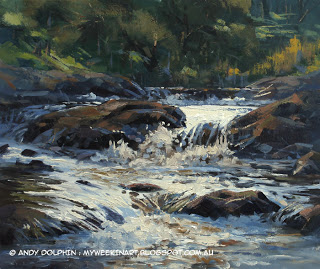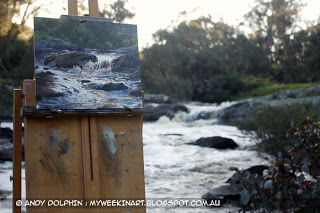This week I was granted access to private property which the Hay River runs through. There is a section a couple of hundred metres long where the river drops over several granite outcrops. We’ve had a very wet start to spring so there is plenty of water in the river.
I’ve never painted rapids plein air before, (I’ve hardly ever painted them at all), so this was going to be a new challenge. Heck, just carrying all my gear down the steep grassy embankment was going to be a challenge.
I hope to visit here several times in the coming weeks, in order to become familiar with it. I’ll begin by attempting exercises, rather than finished paintings. If I can solve one or two problems each time, I should be able to get a decent plein air painting out of it before too long.
Yesterday was the first spring-like spring day we’ve had this spring. It was warm and sunny with clear blue skies. So, in the afternoon I headed down to the river to see if I could manage a painting. Before I started the walk from the car, I emptied as much stuff as I could from my French easel and backpack.
Here’s exercise number one…
I was looking directly toward the sun and the reflections were intense. I actually wandered around for almost an hour to allow the sun to move across a little, but it was still very bright when I started.
Here’s the location shot…
And here’s me doing a “long-distance, time-delay selfie” while pretending to paint…because I could…
We had clear skies again this morning so I returned to the same spot to try the same scene in different light. Here’s the result…
This time the scene was more front-lit, with very few shadows. I assumed some shadows would arrive as I painted since I knew, from yesterday, that the scene would be back-lit by afternoon. I focused in a little closer this time.
And, ta daa, the location shot…
There’s a lot to consider in a scene like this. There’s the various textures of rocks, foliage and water. The water itself presents multiple challenges – flat water, falling water, clear water, flat foam, frothy foam and reflections. Plus, the water is tea-coloured so it takes on distinctly warm hues as it travels over and around the rocks.
Looking at photos of the place, it seems like it should be fairly easy to translate into paint. Some things are dark, some things are light and others are in between. Even the foam patterns and reflections make sense in a photo. But when you’re standing there, paint brush in hand, things never stop moving and every brushstroke requires a good deal of thought.
Once again I find myself wondering why people think painting is good for relaxation. I find it an absolute adrenalin rush, from start to finish.






Thanks Trish. It's almost summer here so I'm hoping to get out again soon and do some more videos.
This comment has been removed by the author.
This comment has been removed by the author.